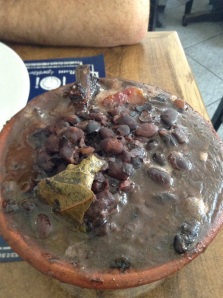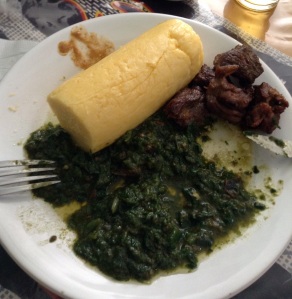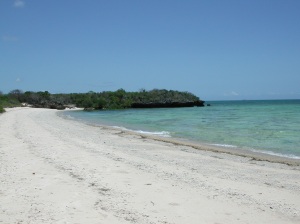Well, not Brazil actually… just São Paulo so far 🙂
After four months in Sampa, as it’s called, we’ve had one or two opportunities to try something new. The first two things that Brasileiros mention when I ask about eats to try is Feijoada and Brigadeiro, both of which I think are an apt representations of Paulistanos (people born in São Paulo), if not Brazil: welcoming and sweet.
Feijoada is a thick, stewy, meaty dish served with rice, ground mandioca and fragrant couve. Besides the rice, everything else on the plate was a new experience the first time… The stew was traditionally made of throw-away bits of meat, and while you can still find that the modern version has tender red meat and bacon bits. Kiernan and I were invited to a birthday party where they had both the traditional and more popular version; they were both super tasty! One thing that is a staple of Brazilian food and always plentiful in a Feijoada pot is beans; since the pot of food is literally stewed for hours you get a thick, tender dish out of it that, to me, whispers “comfort food” in a voice like a soft blanket 🙂
Wednesdays and Saturdays are “feijoada lunch” days and I would not be surprised if people really eat this twice a week, every week. It even encourages your social, sharing side, since a meal of feijoada served at lunch restaurants (or lanchonetes) are big enough to feed two grown men, comfortably!


Brigadeiro is like caramelised, chocolate condensed milk, rolled in more chocolate sprinkles! Yes, it’s very sweet… one bite is quite enough to give you a tweaky sugar high! 🙂 the first Brigadeiro we had was at a friend’s house – his girlfriend threw together a can of condensed milk, a tablespoon of butter and a generous helping of cocoa powder and kept stirring at it on the stove til it was thick and sticky. Yum!! I tried my own version of this, but in an effort to survive with all my teeth, I witheld cocoa powder and rolled the white caramelised condensed milk in cinnamon powder – nice and spicy. 🙂 and very nice with a glass of velvety red wine.
Sweets in Brazil tend to be very sugary and very sweet! It seems like a substantial portion of the population likes chocolate (not just girls); I routinely see people (guy, girl, old, young) polishing of a huge slab of chocolate on the metro! At another birthday party last night they had about four jars of nutella on the counter, spoons jutting out invitingly of the creamy chocolate spread; one jar was being passed around enthusiastically and all indulged 🙂 True, this is merely anecdotal of one sweet experience (pun intended), but I’ve heard that many foreigners complain that sweets here are indeed super sweet.

This was bought at a bakery as opposed to homemad.

Anoter big activity here is churrasco (like BBQ, and actually surprisingly close to braai, especially in the south). Chunks of spiced, marinated meat are threaded on kebab sticks and roasted over a fire; yum! We have yet to try the traditional version of this, but we have had really good meat in Brazil! Not really at restaurants, but at people’s homes or at get-togethers.
The next couple of foodie must-do’s we’re aiming to cross off our list, are trying food from Minas Gerais and Bahia – two places with their own, unique and distinct food cultures. These are just Brazilian eats; São Paulo is well-known for the city you can find any kind of food. While that’s not totally the case (they don’t have biltong, but that may just be nit-picking;), Kiernan and I have had the most deliciously mouth-watering “African food”, in a mostly Cameroonian restaurant; dainty, light and refreshing Columbian cerviche & arepas. The closest you can get to sushi is a fusion of California rolls, cream cheese & fruit… I’m not kidding: cream cheese and strawberry or mango, wrapped in rice & seaweed. o.O ok. It wasn’t bad, but it’s not sushi! 😀

The drinks, cocktails, beer and wine are in a world of their own; perhaps I’ll get enough letters together to write about that soon…

Chocolate, caramel and sweet fried dough, also known as blood pressure roller coaster

This was bought at a bakery as opposed to homemad.

















